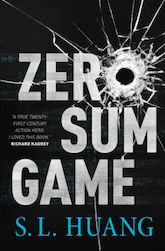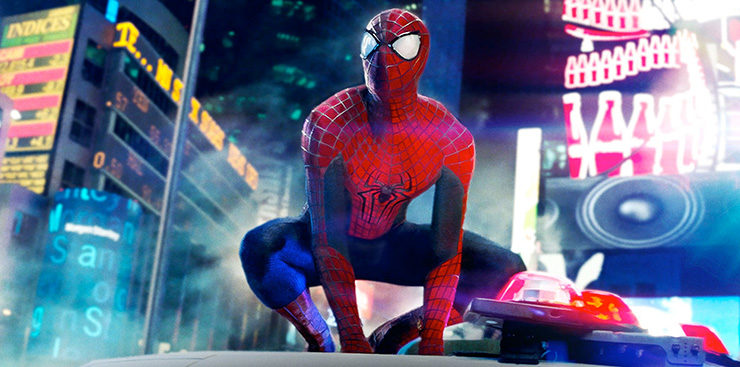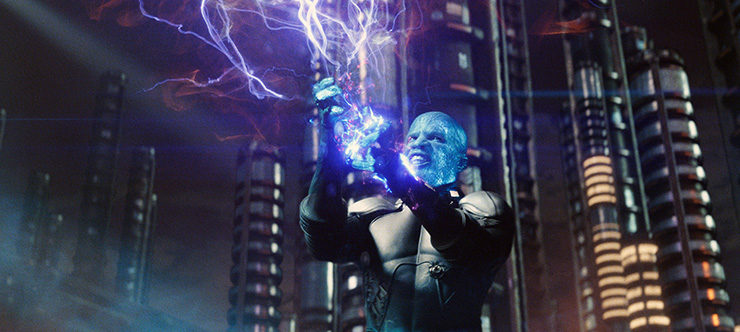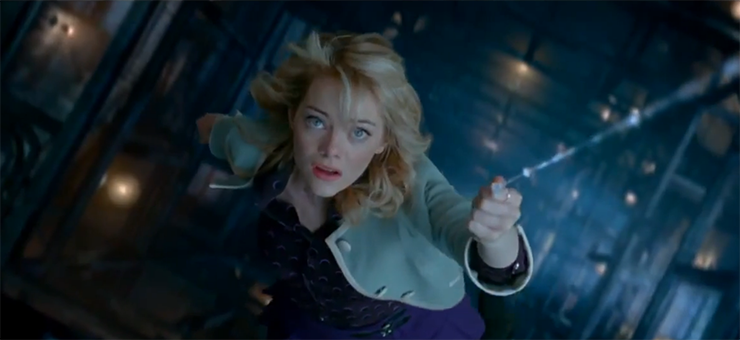Despite the reboot of the franchise, Spider-Man continued to be a hugely popular character, and The Amazing Spider-Man did very well in 2012, continuing the web-slinger’s streak of being a hit almost no matter what. Long the face of Marvel, Spidey’s popularity continued unabated, and Marc Webb was brought back to direct a sequel, with genre veterans Alex Kurtzman & Roberto Orci brought in as co-writers and co-executive producers to help build a new Spider-verse intended to stretch out over many movies—and which instead we wouldn’t really see after this. Kurtzman & Orci had already been involved in the financially successful reboots of Transformers, Star Trek, and Mission: Impossible, so one can understand the desire to add their Midas touch to Spidey.
Having established Norman Osborn’s existence as the unseen, dying head of OsCorp, this movie brings in both Norman (played by Chris Cooper), who dies during the course of the movie, and his son Harry (Dane DeHaan), who was apparently friends with Peter Parker when they were younger (a fact that amazingly never came up in the previous movie, two-thirds of which took place at OsCorp). We get several members of Spider-Man’s extensive rogues’ gallery in this sequel besides the Osborn family: Max Dillon, a.k.a. Electro (Jamie Foxx), and at the very end, the Rhino (Paul Giamatti), plus Michael Massee returns as the mysterious Gentleman.
Andrew Garfield and Emma Stone return as Peter and Gwen, respectively, with Denis Leary appearing as a guilt-induced hallucination of Captain Stacy because Peter keeps vacillating on his promise to stay away from Gwen. Sally Field is back as May Parker, and Campbell Scott and Embeth Davidtz reprise their roles as Richard and Mary Parker in flashback and video form. Colm Feore, fresh off his turn as Laufey the Frost Giant in Thor, plays Donald Menken, replacing Irrfan Khan in the role of sleazy OsCorp executive. Marton Csokas plays Dr. Ashley Kafka, a sympathetic female psychiatrist in the comics, gender- and alignment-flipped in the movie to a male mad-scientist-type, complete with comedy German accent.
Buy the Book


Zero Sum Game
The intent was for this to start a “Spider-Man Cinematic Universe.” With Marvel Studios having proven to be a huge hit after Avengers made, basically, all the money, Sony thought they could take Spider-Man’s very rich history and mine it for a cinematic universe of their own. The end of this movie sets up the Sinister Six, starting with the creation of the Rhino, and movies starring Venom and the Sinister Six were green-lit along with two more Amazing Spider-Man movies. One of the recurring characters was to be Gustav Fiers, a.k.a. The Gentleman, a character who actually originated in tie-in fiction, not comics. The Gentleman was created by Adam-Troy Castro for his “Sinister Six” novel trilogy (The Gathering of the Sinister Six, The Revenge of the Sinister Six, and The Secret of the Sinister Six), and his backstory tied into that of Richard and Mary Parker. (Full disclosure: your humble rewatcher was the Editorial Director of the series of Marvel novels and anthologies, which ran from the mid-1990s to the early 2000s, that included the Sinister Six trilogy, and worked with Adam on developing the storyline.)
However, the lukewarm reception to this film, a clamoring for Spider-Man to be part of the Marvel Cinematic Universe rather than separate, the infamous Sony hack of 2014, and the fact that this film had the lowest box office of any of the five extant Spider-films of the 21st century led to Sony and Disney coming to an arrangement where Spider-Man would be part of the MCU, but only in movies featuring at least one already-established MCU character. Hence his appearance in a Captain America movie and two Avengers movies, as well as Iron Man appearing in Homecoming and Nick Fury appearing in the forthcoming Far from Home.
Sony is continuing Spider-adjacent projects, with Venom having just been released starring Tom Hardy, and with plans for films featuring Silver Sable, Black Cat, and Morbius.
“I love you, don’t hate me!”
The Amazing Spider-Man 2
Written by Alex Kurtzman & Robert Orci and Jeff Pinkner and James Vanderbilt
Directed by Marc Webb
Produced by Avi Arad and Matt Tolmach
Original release date: May 2, 2014
We start again with Richard and Mary Parker leaving their son Peter with May and Ben Parker, but this time it’s from Richard and Mary’s POV. Richard records a final video explaining his actions, and then he and Mary board a private plane that will take them to safety. Except OsCorp has an assassin embedded as the copilot. The assassin kills the pilot and is about to jump out of the plane to safety with a parachute, and also with the laptop containing their research, which Richard was about to upload to a satellite. However, both Mary and Richard manage to fight off the assassin, taking away his parachute and throwing him from the plane, and also getting the data uploaded. But they both die in the crash (Mary’s also been shot by the assassin).
In the present, Spider-Man stops a hijacking of an OsCorp truck containing plutonium, led by a Russian mobster named Aleksei Sytsevich. Spider-Man stops him, and barely makes it to his high school graduation in time to get his diploma. He completely misses Gwen Stacy’s valedictorian speech. (During the rescue, he saves the life of a neurotic OsCorp electrical engineer named Max Dillon.) As he arrives at graduation and takes his diploma, an attendee who looks just like Stan Lee says, “I know that guy!”
Peter has been guilty about continuing his relationship with Gwen after Captain Stacy asked him to end it, and he shares this with Gwen while standing outside the restaurant where her family is having dim sum. Fed up with his indecision, she breaks up with him.
Harry Osborn returns to New York to visit his dying father. It’s not a pleasant reunion—Harry mentions Norman sending him a bottle of Scotch for his sixteenth birthday with a note saying, “Best regards, Norman Osborn”—but Norman reveals that Harry has the same genetic disease that’s killing Norman. He’s hoping his son can find a cure.
Norman dies, and Harry is made president of the company—which doesn’t sit well with the vice president, Donald Menken. Because of the embarrassment of Curt Connors’s rampage through New York as the Lizard, all the work with cross-species genetics, including all the animal test subjects, have been destroyed.
It turns out that Peter and Harry were best friends as little kids before Harry was sent off to boarding school. Peter goes to see him, remembering that little Harry was there for him when his parents were killed. They bond and catch up a bit.
Dillon goes into work on his birthday, which nobody acknowledges. Spider-Man saving his life has prompted him to formulate an entire fantasy life where Spidey is his best friend. Dillon has designed a power grid that OsCorp has sold to the city of New York to provide power. Maintenance needs to be done on it, and Dillon is forced to stay after closing to do the work—but the person responsible for shutting off the power so he can work there is also gone for the day, so Dillon fixes it while it’s active—only to be electrocuted and fall into a vat filled with electric eels (the existence of which is never explained by the script). Dillon’s electrocuted body is brought to a morgue beneath OsCorp and Menken orders a cover up.
However, Dillon isn’t dead. He comes back to life and is now able to control electricity. He sucks power out of anywhere he can get it, finding himself eventually in Times Square. Spider-Man confronts him, and he even remembers saving his life (though he doesn’t remember his name). Between forgetting his name, and Spider-Man’s insistence on stopping him from endangering innocent lives (he’s already hurt many people and almost killed a few), Dillon’s love for Spider-Man becomes hate. Spidey manages to stop him by dousing him with a fire hose, thought not before Dillon is able to fry his web shooters. Dillon is sent to the Ravencroft Institute—publicly, a psychiatric hospital, in reality an OsCorp front. Dr. Ashley Kafka runs experiments on Dillon while he’s there.
Harry discovers that the research Richard Parker was doing with spiders might have led to a cure for what is killing him. He asks Peter—who has been selling pictures of Spider-Man to the Daily Bugle—to ask Spider-Man for a blood sample. Peter returns as Spider-Man to refuse, saying it’s too dangerous. Harry is livid.
Peter digs into his father’s research and tries to figure out what he was doing with spiders, especially given how he got his powers. May admits that after Richard and Mary died, she and Ben were visited by government agents who said that Peter’s parents were traitors.
Eventually, Peter figures out that his parents kept a secret lab in an abandoned subway station that was used by President Franklin Roosevelt to get him in and out of New York in such a way as to hide his polio from the general public. (In the real world, this is Track 61, which still gets occasional use as a presidential bolthole today, though it is under the Waldorf Astoria Hotel, not on the D line.) Peter sees a recording his father made the day Peter found Richard’s office trashed—OsCorp is using his research for biological weapons, not just to cure disease, and Richard refused to be a part of that, so he ran away, even though he knew it would mean abandoning his son, rather than take him with them to live the life of a fugitive.
Gwen informs Peter that she’s been offered a scholarship to Oxford University. Peter is devastated, and doesn’t want her to go, but she thinks it’s best rather than continue their insane on-again-off-again relationship.
Harry is pissed because the spiders that Menken destroyed might have had the key to curing his disease, but his assistant Felicia informs him that they did save some of the venom. However, before he can go obtain it, he’s escorted from the building. Menken framed him for the cover-up of Dillon’s death.
Now without his cushy-tushy position as president of the company, Harry needs access to OsCorp. He goes to Ravencroft and bluffs his way inside and makes Dillon a deal: Harry will free the self-styled “Electro” in exchange for his help getting into OsCorp, and they’ll both get their revenge on Spider-Man. Dillon agrees.
They break into OsCorp, Dillon now having access to the entire power core, while Harry forces Menken to inject him with the spider serum. It starts to transform Harry, but he gets into an experimental exoskeleton that happens to be nearby. Said exoskeleton identifies his genetic disease and cures it, apparently. Why this hasn’t been put into mass production is never explained.
Peter webs the words “I love you” onto the Brooklyn Bridge and then kidnaps Gwen from her cab to the airport and takes her to one of the bridge’s spires. He says he loves her and doesn’t care what her father said or anything else, he’s staying with her forever, even if it means flying to England. (He allows as how they have crime there too, though the only example he can come up with is that they haven’t caught Jack the Ripper yet.)
Dillon goes to the power grid itself and absorbs it, blacking out the entire city. Gwen suggests using magnetics to keep Spidey’s web shooters from being fried like they were the last time, and also suggests overloading Electro so he burns out. She knows the specs of the power grid, so she can work it while he overloads Electro. Spider-Man refuses to bring her along at first, webbing her to a police car before he goes off.
He and Electro fight. Eventually, Gwen shows up in the very police car she was webbed to (it’s good to be the daughter of a respected captain), and she works the grid while he fights Electro.
Once they succeed in overloading Electro, Harry shows up on the glider that comes with the exoskeleton. (Why he waited until Spider-Man was done with Electro is left as an exercise for the viewer.) When he sees Gwen—whom he knows is dating Peter—working with Spidey, Harry realizes that Peter and Spider-Man are one and the same. He kidnaps Gwen and flies off with her. Spider-Man tracks them to a big clock tower where they have a lengthy battle involving clockworks and such. At one point, Spider-Man has subdued Harry, but then Gwen falls down the length of the tower. Spider-Man shoots out a web line to grab her, but the impact snaps her neck. (The impact with the floor would have been far worse, of course.)
Peter attends the funeral and then spends the next five months moping. Spider-Man seems to have disappeared, and from prison, Harry—with the aid of the Gentleman who visited Connors at the end of the last movie—orchestrates the creation of a team of bad guys who will thrive in a world without Spider-Man. They start by freeing Sytsevich from prison and giving him another OsCorp exoskeleton that’s just lying around (seriously, how do they make money if they don’t actually market this stuff?). Since the exoskeleton is vaguely rhinoceros shaped, Sytsevich is now calling himself “the Rhino” and starts shooting up Park Avenue. A little kid in a Spider-Man suit runs out to confront him, but then the genuine article shows up for the first time in five months to confront him.
“A god named Sparkles?”
This movie has the opposite problem of its predecessor. In that movie, the pacing was slower than molasses in January, with everything taking way longer than it should have. This movie doesn’t have time for that, because there’s so much happening here, and the vast majority of it just isn’t that interesting.
The Amazing Spider-Man 2 reminds me very much of Batman Forever, Batman & Robin, Superman IV: The Quest for Peace, X-Men: The Last Stand, and Spider-Man 3. This is not a good thing. Too many villains, too many things going on, plot points that just happen because the script calls for it, and—as with the last two in particular—character deaths that occur because they happened in the original comics being adapted, but have nowhere near the resonance.
Let’s start with this, because it’s my biggest problem with this movie: Gwen Stacy dies in the end. On the one hand, yes, she died in the comics. Hell, it’s one of the four or five most famous deaths in a comic book. In many ways the character is better known for having died than for what she was when alive, which is too bad, as she was actually a pretty damned awesome character. That’s why her death was so effective, in fact. (Thank goodness for Spider-Gwen, which mines Marvel’s copious use of alternate timelines to give us the heroic Gwen we all deserve without actually reversing yet another character death.)
The thing is, that’s not a good enough reason to kill her off in this movie. Yes, it happened in the comics. You know what else happened in the comics? Peter was bitten by a radioactive spider, not a genetically engineered one. Peter’s father and mother were secret agents, his father wasn’t a scientist who experimented with spiders. Peter entered a wrestling competition and let a thief steal the receipts, not a guy robbing a bodega, and that guy killed his uncle while robbing their house, not out on the street. Max Dillon was a janitor, not an electrical engineer. The Osborns don’t have a genetic disease, and Norman was the one who became the Green Goblin first. Dr. Kafka’s a compassionate woman not a psychotic man with a stupid accent. For that matter, Gwen died without ever knowing that Peter was Spider-Man.
They didn’t feel the need to pay attention to any of that other stuff, so why be beholden to superhero comics’ most famous fridging?
It’s frustrating especially because the parts of this Frankenstein’s monster of a movie that actually work are the scenes between Peter and Gwen. Andrew Garfield and Emma Stone’s chemistry has actually improved since the previous film and they make a fantastic couple. (The conversation while hiding in the closet is my personal favorite, but it’s just one of dozens.) In particular, I love that Gwen insists on helping Spider-Man whether he wants it or not. (I would say whether he needs it or not, but he does, in fact, need it. Several times.) They make a phenomenal team, and killing her just comes across as lazy writing.
Speaking of lazy writing, we have the utterly superfluous Electro subplot, in which Jamie Foxx embarrasses himself with a storyline that has been lifted lock, stock, and lightning bolts from the Jim Carrey version of the Riddler in Batman Forever: nebbishy guy played by a former In Living Color cast member who works for the big company in town imprints on our hero and then views him as having betrayed him and gets crazy-ass powers and turns evil. It was awful in 1995, and it was just as awful in 2014. It’s also just like the Sandman subplot in Spider-Man 3, as you could remove it from the movie, and it wouldn’t change it a bit. Well, it would make it shorter, which would only be a good thing…
Garfield isn’t much better than he was the last time. He has his moments, mostly in his banter with Stone, but his Spidey dialogue is all distressingly cornball and weak. His conversations with May are stilted and not at all compelling. Without Martin Sheen to play off of, and without a script that actually knows what to do with May, poor Sally Field is again left floundering with an undercooked role.
As with the last movie, things happen because the plot says they do, but they don’t make much sense. Retconning Harry Osborn as Peter’s childhood friend makes no sense (again, this should’ve come up in the previous movie), and Harry’s turning on Spider-Man is only slightly more convincing than Electro’s. This is one case where they decide to go ahead and repeat themselves, as Dane DeHaan’s emo Harry follows the same character beats as James Franco’s, only Franco’s a better actor.
It’s never explained why OsCorp has all these high-tech toys lying around that they don’t actually seem to sell to anyone. Seriously, nothing we see at this company actually seems to have any practical applications—the genetically engineered spiders, the cross-species genetic project, the various exoskeletons that seem to be just there. Okay, yeah, OsCorp has apparently replaced Con Edison as the supplier of New York’s electrical power, but I can’t imagine that alone is keeping the company afloat…
The opening bit is fun—watching Campbell Scott and Embeth Davidtz kick ass before being killed is kinda nifty—and as the editor who worked with Adam-Troy Castro on his Sinister Six trilogy, and who helped develop the Gentleman, I’m disappointed that we didn’t see more of the character on film, as it’s rare to see a character that originated in derivative fiction become a major character. (Not unheard of, of course, as Harley Quinn is perhaps the most popular example…) Paul Giamatti is obviously having a grand old time hamming it up with a comedy Russian accent as the Rhino, and I will give the movie credit for the misdirect of having Peter and Gwen on the Brooklyn Bridge (where she was killed in the comics) only to have her die at a different location. (And yes, the dialogue in Amazing Spider-Man #121 says George Washington Bridge, but Gil Kane drew the Brooklyn Bridge, and the next issue had him in lower Manhattan after leaving the bridge, not upper Manhattan. It was later retconned to the Brooklyn Bridge officially, which is what it always should have been anyhow, as the GWB is too far from where all the other events around Gwen’s death were happening to make sense.)
But there was no need to kill her at all. It’s just one of many missteps made by this misbegotten reboot that didn’t really deserve to have any more films after it.
Next week, we harken back to those thrilling days of yesteryear, as we get our first (but very far from our last) look at Josh Brolin in this rewatch, this time as the title character in Jonah Hex.
Keith R.A. DeCandido has always loved Spider-Man, and his first-published short story and his first novel were both collaborative Spidey tales: the short story “An Evening in the Bronx with Venom” (written with John Gregory Betancourt) in the 1994 anthology The Ultimate Spider-Man, and the novel Venom’s Wrath (written with José R. Nieto) in 1998. He also wrote the short story “Arms and the Man” in 1997’s Untold Tales of Spider-Man and the 2005 novel Down These Mean Streets.












